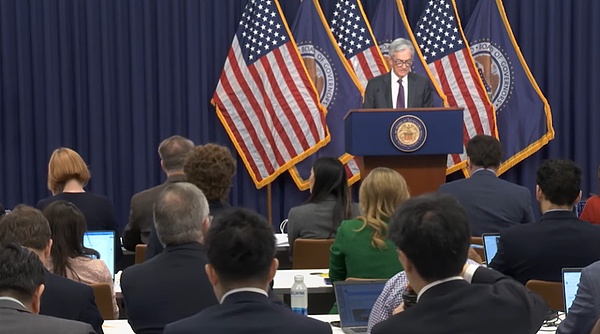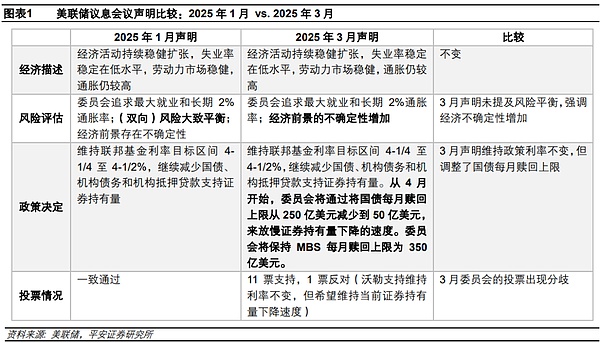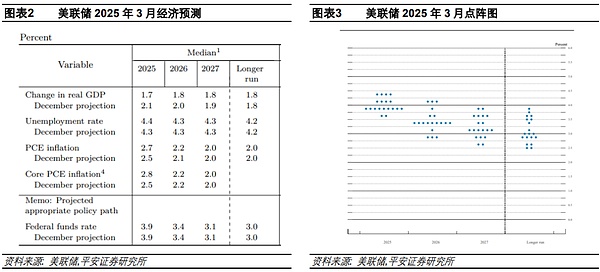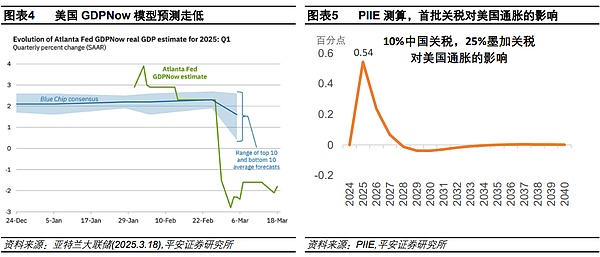Author: Ping'an First Economics Team; Source: Zhong Zhengsheng Economic Analysis
Core Viewpoint
On March 19, 2025 (US time), the FOMC meeting statement and economic projections were released by the Federal Reserve, and Chair Powell gave a speech. Subsequently, the market trading style was similar to "accommodative trading": the 10-year US Treasury yield fell 8BP to 4.24%, the three major US stock indices rose, the US dollar index fell, and gold broke through $3,050 per ounce during the session.
Meeting Statement and Economic Projections: No rate cut as expected, still expect two rate cuts within the year. The FOMC meeting in March 2025 maintained the federal funds target rate range at 4.25-4.50%, plans to further slow the pace of balance sheet reduction starting in April, reducing the pace of Treasury runoff from $25 billion to $5 billion per month. Compared to the January 2025 statement, the description of the economic outlook has changed from "uncertainty" to "increased uncertainty", and the statement of "broadly balanced (two-way) risks" has been removed, indicating the Fed's increased concern about economic uncertainty. FOMC member Waller voted against slowing the balance sheet reduction. In terms of economic projections, the median 2025 GDP growth forecast was significantly revised down from 2.1% to 1.7%, the unemployment rate forecast was revised up from 4.3% to 4.4%, and the median PCE and core PCE inflation forecasts were revised up by 0.2 and 0.3 percentage points to 2.7% and 2.8% respectively; the 2025 policy rate is expected to remain at 3.9% (two rate cuts), and the dot plot shows a slight weakening of rate cut expectations for 2025.

Powell's speech: "Staying the course" in response. The core idea of Powell is that policies such as tariffs have brought great uncertainty to US inflation and economic outlook, and the Fed has chosen or is forced to "stay the course" and maintain a high degree of monetary policy flexibility. The key messages he conveyed include: 1) It is difficult to assess the specific contribution of tariffs to inflation, but he believes that (long-term) inflation expectations remain stable. 2) He believes the US economy remains robust, as "hard data" such as employment and consumption are not weak, only some survey-related data have weakened; the probability of a US recession, though rising, is still not high. 3) The Fed does not need to curb inflation at the cost of a recession like in the 1970s. 4) Financial markets, including the stock market, are important, but financial market volatility needs to be sustained to be a major focus. These remarks have to some extent alleviated market concerns about "stagflation" in the US.
Policy Considerations: The economic and rate cut outlook still needs to be reassessed; Slowing the balance sheet reduction may be an expedient measure. Is the Fed willing and able to cut rates in a timely manner to support the economy and the stock market, against the backdrop of upside inflation risks? It is difficult to judge from this meeting. The Fed may have expressed optimism about the US economy. However, we remain cautious about Powell's view that the "hard data" of the US economy still has resilience. We also have reason to be concerned that the Fed's inflation assessment may be too optimistic: the Fed may not have fully factored in the impact of tariffs; the upside risks to inflation expectations have not been adequately addressed. We believe that compared to the baseline expectation of a 50BP rate cut for the full year, the more likely deviation is that the downward pressure on the US economy exceeds the Fed's current assessment, leading to the risk of the Fed cutting rates too late in the first half and "catching up" in the second half, resulting in an actual rate cut of more than 50BP for the full year. A positive factor is that the Fed has announced a relatively decisive slowdown in balance sheet reduction, which may also be an important consideration for the Fed to "stay the course" on interest rates for now.
Risk Reminder: The US economy and employment weaken more than expected, US inflation rises more than expected, and US policy uncertainty remains high.
The FOMC meeting in March 2025 kept rates unchanged as expected, but announced that it will further slow the pace of balance sheet reduction starting in April. The latest economic projections have been revised down for growth and up for inflation, but the median rate path still expects two rate cuts within the year, although the dot plot shows a slight weakening of rate cut expectations for 2025. The core idea of Powell's speech is that policies such as tariffs have brought great uncertainty to US inflation and economic outlook, and the Fed has chosen or is forced to "stay the course" and maintain a high degree of monetary policy flexibility. Powell's remarks have to some extent alleviated market concerns about "stagflation" in the US. However, we believe that compared to the baseline expectation of a 50BP rate cut for the full year, the more likely deviation is that the downward pressure on the US economy exceeds the Fed's current assessment, leading to the risk of the Fed cutting rates too late in the first half and "catching up" in the second half.
1. Meeting Statement and Economic Projections: No rate cut as expected, still expect two rate cuts within the year
The FOMC meeting statement in March 2025 maintained the federal funds target rate range at 4.25-4.50%, in line with market expectations; at the same time, the Fed plans to further slow the pace of balance sheet reduction starting in April, reducing the pace of Treasury runoff from $25 billion to $5 billion per month, without changing the $35 billion per month pace of MBS runoff.
Compared to the January 2025 statement, this statement's assessment of current economic activity, unemployment, labor market and inflation is unchanged, but the description of the economic outlook has changed from "uncertainty" to "increased uncertainty", and the statement of "broadly balanced (two-way) risks" has been removed, indicating the Fed's increased concern about economic uncertainty. In addition, one member (FOMC member Waller) dissented on the policy decision, with the statement showing that he supported keeping rates unchanged but opposed slowing the balance sheet reduction, wanting to maintain the current pace of securities holdings reduction.

The key changes in the Fed's March 2025 economic projections (SEP) compared to December 2024 include:
1) Economic Growth: The 2025 median GDP growth forecast was significantly revised down from 2.1% to 1.7% (slightly below the Fed's long-term growth estimate of 1.8%), and the 2026-2027 growth forecasts were revised down from 1.9-2.0% to 1.8%.
2) Employment: The 2025 median unemployment rate forecast was revised up from 4.3% to 4.4%, maintaining the 4.3% and 4.2% forecasts for 2026-2027 and the long-term, respectively.
3) Inflation: The 2025 median PCE and core PCE inflation forecasts were revised up by 0.2 and 0.3 percentage points to 2.7% and 2.8% respectively; the 2026 and 2027 forecasts for both measures are 2.2% and 2.0%, respectively, and the long-term forecasts for both are 2.0%.
4) Interest Rates: The 2025 median policy rate forecast remains at 3.9% (two rate cuts within the year), the 2026 median policy rate forecast remains at 3.4%, and the long-term policy rate forecast remains at 3.0%.
5) Dot Plot: For 2025, among the 19 officials, 4 now expect no rate cuts (up 3 from last time), 4 expect only one rate cut (up 1), 9 expect two rate cuts (down 1), and only 2 expect three or more rate cuts (down 3). It is evident that although the median forecast is unchanged, the officials' expectations for rate cuts in 2025 have generally weakened.

2. Powell's Speech: "Unchanged" Adaptation
Overall, the main focus of this press conference was how the Federal Reserve views the outlook for inflation, the pressure of economic slowdown, and the considerations for maintaining the forecast of two rate cuts within the year. Powell's core idea is that policies such as tariffs bring great uncertainty to the US inflation and economic outlook, and the Federal Reserve has chosen to "remain unchanged" in response, maintaining a high degree of flexibility in monetary policy. The key information it conveys includes: 1) It is difficult to assess the specific contribution of tariffs to inflation, but it is believed that (long-term) inflation expectations remain stable. 2) The US economy is still robust, as "hard data" such as employment and consumption are not weak, only some survey data related to expectations have weakened; the probability of a US economic recession, although rising, is still not high. 3) The Federal Reserve does not need to curb inflation at the cost of a recession as in the 1970s. 4) Financial markets, including the stock market, are important, but market volatility needs to be sufficiently sustained to be a focus of attention. These remarks have to some extent alleviated market concerns about "stagflation" in the US.
After the statement and Powell's speech, the market trading style was similar to "loose trading": the 10-year US Treasury yield continued to decline, falling 8BP from around 4.32% to around 4.24%; the three major US stock indexes expanded their gains, with the Nasdaq, S&P 500 and Dow Jones closing up 1.41%, 1.08% and 0.92% respectively for the day; the US dollar index fell from its high near 104 to around 103.5, but still closed up 0.2% for the day; gold spot prices rose, breaking through $3,050 per ounce to hit a new high during the session, and closed up 1.1% for the day.
Specifically:
1) On inflation. The topic of inflation was the most frequently asked question at this press conference. Many questions asked how the Federal Reserve evaluates the specific impact of tariffs on inflation. Powell said that for now, it can only be said that part of the inflation comes from tariffs, but it is difficult to accurately assess their contribution; commodity inflation has risen significantly in the first two months of 2025, closely related to the implementation of tariffs, but the specific impact is difficult to quantify. Regarding inflation expectations, a reporter mentioned that current surveys show that short-term inflation expectations have risen, and asked whether this would change the Federal Reserve's assessment of inflation. Powell acknowledged that short-term inflation expectations have indeed risen, partly due to the implementation of tariffs, with businesses, households and market participants all mentioning the impact of tariffs on inflation. But he emphasized that when talking about "well-anchored inflation expectations", he mainly refers to long-term inflation expectations; current indicators of long-term inflation expectations (such as the 5-year or 5-year forward breakeven inflation rate) are flat or slightly down. But he also stressed that the Federal Reserve will closely monitor all inflation expectation data and will not ignore any signs of changes in long-term or medium-term inflation expectations.
2) On the expectation of two rate cuts within the year. Many reporters questioned why the Federal Reserve still expects two rate cuts within the year, given that the inflation forecast has been revised up and inflation risks have increased. In summary, Powell believes: 1) The slowdown in economic growth and the rise in inflation to some extent offset each other, and the overall economic situation has not shown obvious signs of recession. 2) The current economic situation is highly uncertain, "in this highly uncertain environment, people may choose to maintain the status quo". 3) The current policy stance can cope with the uncertainty, choosing to wait for clearer economic signals to ensure the timeliness and effectiveness of policy adjustments.
3) On the balance of two-way risks. A reporter pointed out that the statement this time deleted the phrase "the risks to the employment and inflation objectives are roughly balanced", and asked whether this change means that the Federal Reserve is more focused on inflation or employment. Powell said that the Federal Reserve has now passed the stage where it needs to particularly emphasize the balance of risks, so this sentence was deleted. This does not mean that the Federal Reserve is more focused on inflation or employment, but rather reflects the changes in the current economic situation and the high degree of uncertainty, especially the impact of changes in government policies (such as trade, immigration, fiscal policy and regulation) on the economy, which have not yet fully emerged, making the expression of risk balance no longer applicable.
4) On the economy and employment. A reporter asked whether the slowdown in economic growth will affect future spending and investment. Powell emphasized that although the economic growth has slowed, the "hard data" (such as employment, consumer spending) remains robust, especially with the unemployment rate remaining at a low of 4.1%, the economic growth is still in a reasonable state. A reporter asked why the hiring rate is still at a relatively low level when the unemployment rate is close to 4%; whether the structure of employment growth indicates that private sector employment growth is weak. Powell said that the labor market situation is still healthy; although the unemployment rate is close to the natural rate of unemployment, the hiring rate and layoff rate are both low, indicating that the labor market is in a state of low activity balance; over the past year, employment growth has indeed been concentrated in areas such as educational institutions, healthcare, and government, but the private sector has also performed well; from the Federal Reserve's perspective, employment is employment, and policy will not differentiate between different types of employment.
5) On the risk of recession or stagflation. A reporter asked whether the current economic slowdown will increase the likelihood of a recession. Powell pointed out that the possibility of a recession has always existed, usually around a quarter; looking back, at any time there is a quarter chance of a recession within the next 12 months; although external forecasting agencies have generally raised the likelihood of a recession, this probability is still at a relatively moderate level, still within the traditional range. A reporter asked whether the Federal Reserve will, like in the 1970s, curb inflation at the cost of an economic recession. Powell jokingly said that "unfortunately", the current situation is different from the 1970s, as inflation has fallen from a higher level to around 2%, and the unemployment rate is maintained at 4.1%, so there is no need to emulate the response strategies of the 1970s.
6) On the stock market. A reporter asked whether the Federal Reserve is concerned that market volatility, including the sharp decline in the stock market since the last Federal Reserve meeting, will have an impact on the real economy. Powell pointed out that the state of financial markets (including the stock market) is important to the Federal Reserve, as this is the main channel through which monetary policy affects the real economy. But he stressed that the Federal Reserve will not comment on the reasonable level of any market, but will focus on changes in macroeconomic data from a macro perspective; changes in financial markets will affect economic activity, but this impact needs to be substantive, sustained, and sustained long enough to become a focus of attention for the Federal Reserve. He believes that sentiment data (such as consumer confidence surveys) show concerns and downside risks, but these have not yet translated into obvious weakness in actual economic activity.
Here is the English translation:7) Regarding the slowdown in balance sheet reduction. The reporter asked why the Federal Reserve decided to slow the pace of the decline in the size of the balance sheet, and whether this adjustment is related to the debt ceiling issue? Powell pointed out that slowing the pace of the decline in the balance sheet size is a technical decision; the reduction in the Treasury General Account (TGA) balance has led to an increase in reserves, which has caused some tightening in the money market; the discussion of adjusting the pace of balance sheet reduction was indeed initially triggered by the flow of funds from the TGA account, but this adjustment is not just to address the debt ceiling issue. He emphasized that this adjustment is unrelated to the monetary policy stance and will not affect the ultimate size of the balance sheet; slowing the pace of balance sheet reduction helps ensure a smoother and more predictable balance sheet reduction process. Regarding not adjusting the pace of MBS reduction, Powell said there are currently no plans to adjust the pace of MBS reduction, and the Federal Reserve will continue to gradually reduce MBS; moreover, the Federal Reserve may continue to reduce MBS while maintaining the overall size of the balance sheet, but it has not yet reached that stage and has not made a decision on it.
3. Policy Considerations: Economic and Rate Cut Outlook Still to be Reassessed; Slowing Balance Sheet Reduction May Be a Stopgap Measure
The key issue that the market is most concerned about in this meeting is whether the outlook for rate cuts will change. On the one hand, since the Federal Reserve's January policy meeting, more signs of economic weakness have emerged in the U.S., and the U.S. stock market (S&P 500 index) has seen a 10% level of adjustment, and the market hopes that the Federal Reserve will consider more timely and decisive rate cuts, or at least communicate this intention to the market. But on the other hand, the "New Federal Reserve News Agency" published an article on March 18 "predicting" that Federal Reserve officials may further downgrade their forecast for rate cuts this year, from 2 cuts in December to 1-2 cuts[1], which has also caused U.S. bond yields and the U.S. dollar index to rise ahead of the release of the Federal Reserve's statement.
At this meeting, the dot plot indeed showed that officials' rate cut expectations have been slightly lowered overall, but fortunately the median forecast remains unchanged, still forecasting 2 rate cuts by 2025, so investors may not feel too "hawkish". But will the Federal Reserve be willing to cut rates in a timely manner to support the economy and the stock market, given the upside risks to inflation? From this meeting, it is difficult for us to judge. One key reason is that the Federal Reserve may have intentionally expressed optimism about the economy, which naturally avoids discussing the scenario of needing to cut rates due to economic downturn. This includes the latest economic forecast still projecting 1.7% economic growth in 2025 and a slight rise in the unemployment rate to 4.4%, which is only slightly weaker than the long-term reasonable level, and cannot be considered a significant economic slowdown, let alone a "recession".
But we remain cautious about Powell's view that the "hard data" of the U.S. economy still has resilience. The GDPNow model as of March 18 forecasts that U.S. first-quarter GDP will contract at an annualized rate of -1.8%, with consumption growing only 0.4%. It should be noted that the data underlying this model are mostly "hard data" closely related to GDP accounting (including recent retail sales, real estate, etc.). At least in the first quarter, the "hard data" of the U.S. economy may have already shown a significant cooling. Following this trend, the full-year economic growth forecast may still have room for downward revision.
We also have reason to be concerned that the Federal Reserve's assessment of inflation may be too optimistic. On the one hand, the Federal Reserve may not have fully accounted for the impact of tariffs, at least not reflected in the latest forecast. The 2025 U.S. PCE and core PCE inflation rates have only been revised up by 0.2-0.3 percentage points. According to PIIE's estimates, the combination of 10% China and 25% Canada/Mexico tariffs (not considering retaliation) may collectively raise 2025 U.S. inflation by 0.54 percentage points, not to mention that the current tariffs on China have been raised to 20%, and there is a possibility of additional tariffs on products such as automobiles, pharmaceuticals, semiconductors, lumber, and agricultural products after April, as well as the potential for increased inflation risks from trade partners' retaliation. On the other hand, the risk of rising inflation expectations has not been given enough attention. The latest 1-year and 5-year inflation expectations from the Michigan survey have reached 4.9% and 3.9% respectively, up 2.1 and 0.9 percentage points respectively from December 2024. Since short-term inflation expectations can also influence the behavior of households and businesses, leading to a "self-fulfilling" effect on inflation, Powell's statement that "inflation expectations are stable" by only looking at "long-term inflation forecasts" may not be entirely scientific.

We believe that compared to the baseline expectation of a 50BP rate cut for the full year, the more likely deviation is that the downward pressure on the U.S. economy exceeds the Federal Reserve's current assessment, which could lead to the risk of the Federal Reserve cutting rates too late in the first half and "catching up" in the second half. This could result in the actual rate cut for the full year exceeding 50BP.
One positive factor is that the Federal Reserve has relatively decisively announced a slowdown in balance sheet reduction and a slowdown in the pace of Treasury reduction. Although Powell emphasized that this decision is unrelated to the monetary policy stance, slowing the balance sheet reduction, by reducing the supply of Treasuries and lowering U.S. Treasury yields, has a positive effect on the economy and the stock market, and may objectively partially serve the function of rate cuts. This may also be an important consideration for the Federal Reserve to temporarily "stand pat" on interest rates. From this perspective, the Federal Reserve may not be overly focused on controlling inflation in the future, but may not be indifferent to the needs of the economy and the market.
Risk Reminder: The U.S. economy and employment are weaker than expected, U.S. inflation is higher than expected, and U.S. policy uncertainty is relatively high.







